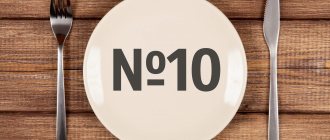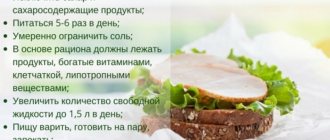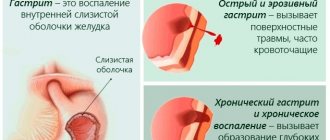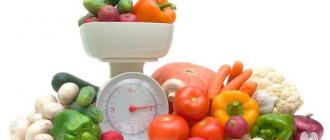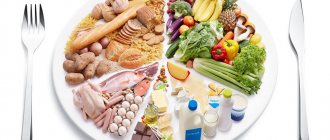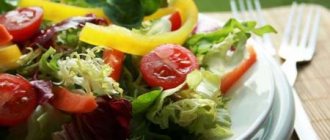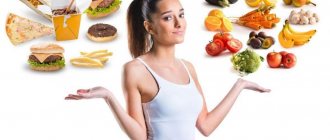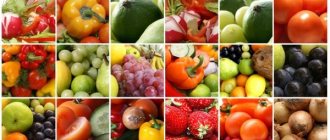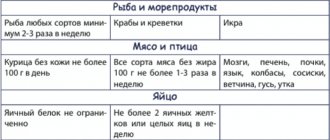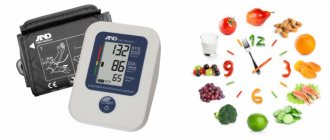Diet No. 3 is a special nutrition program developed by the famous Soviet scientist, gastroenterologist-nutritionist Manuil Pevzner. This therapeutic diet is prescribed for chronic intestinal diseases accompanied by constipation. Problems with regular bowel movements are quite common, most often caused by poor diet, sedentary lifestyle and poor quality food. Most working people, as well as students, are exposed to all these factors. Also, diet No. 3 is often prescribed to older people, since intestinal motility worsens with age.
Chronic, prolonged constipation leads to serious complications such as colitis and rectal diseases. The third diet according to Pevzner will prevent these consequences in time. Read more about the diet, what you can eat, how to cook and how to finally return to the regular menu.
Diet table No. 3: indications for use for men, women, children
Attending physicians prescribe diet No. 3 to improve performance in a variety of protracted intestinal diseases, such as constipation and impaired peristalsis. It is also possible to prescribe it in the postoperative period for strip operations.
Diet No. 3 allows you to eat a lot of foods, so sitting on it is a pleasure
The main causes of diseases for which diet No. 3 is indicated are:
- Congenital intestinal problems ;
- Sedentary lifestyle (sedentary work or little physical activity significantly increases the risk of developing gastrointestinal diseases);
- Unbalanced diet and improper food intake (especially dangerous for those who like to eat a lot at night, since intestinal function slows down during sleep);
- The birth of a child (malnutrition during pregnancy often disrupts metabolism, and the growing fetus puts pressure on the excretory tract, reducing the intestinal lumen, which prevents the release of feces);
- Incorrect diet for weight loss (an incorrectly designed nutrition plan leads to an imbalance in the functioning of the entire gastrointestinal tract);
Poor nutrition can also worsen intestinal function. Those
at risk for gastrointestinal diseases include:
- office workers who are somehow forced to spend a lot of time at their desks
- overweight people
- workers with irregular work schedules
- future mothers
- drivers of vehicles, especially workers in long-distance land transportation and others
The third table is recommended for treatment:
- Hemorrhoids
- Anal fissures
- Zaporov
- Flatulence
- Other chronic intestinal diseases
Sometimes intestinal diseases are additional to the main diseases. In this case, it is necessary to eliminate, first of all, the cause of all troubles, and then deal with the gastrointestinal tract.
Diet No. 3 is a good basis for losing weight and cleansing the body, since it cuts off all unnecessary food products, leaving the most healthy and nutritious ones.
Main characteristics of the diet
The main goal of following the dietary recommendations of table 3 according to Pevzner is to increase the peristaltic movements of the walls of the small and large intestines, which are aimed at moving the contents into the lower parts of the digestive tract. The diet includes several basic general characteristics:
- Complete provision of the human body with all necessary organic compounds, vitamins, and minerals.
- Inclusion in the diet of certain foods rich in plant fiber, thereby increasing the motor peristaltic activity of the intestine.
- Ensuring sufficient fluid intake from food, which helps soften stool and facilitates its removal from the large intestine.
- Exclusion from the diet of dishes and food products that provoke the development of fermentation and putrefactive processes in the intestines (foods rich in essential oils, fried, fatty foods).
- A gentle regime for the intestines is not required if dietary recommendations are followed, so food does not need to be crushed; steaming, boiling, stewing, and baking are allowed. Vegetables and fruits can be eaten raw.
Diet 3 includes the following ratios and quantities of the main components:
- Proteins – 100 g, of which 55% should be of animal origin.
- Fats – 100 g, of which 70% are lipids of animal origin.
- Carbohydrates – 350-400 g, while preference should be given to plant fiber, which promotes intestinal motility.
- Liquid – up to 1.5 l.
- Table salt (sodium chloride) – up to 15 g.
- Daily energy value is 2800-3000 kcal.
- The weight of the daily diet is up to 3 kg.
The recommended eating regimen is 4-6 times a day. For better functioning of the hollow structures and digestive glands of the gastrointestinal tract, portions should be small.
Diet table No. 3: allowed foods
Most of the diet in diet No. 3 is filled with foods that improve intestinal motility. These are mainly high-fiber foods and fermented milk products.
Foods rich in fiber are recommended for consumption.
For those who suffer from intestinal obstruction, it is advised to increase the consumption of laxative foods, such as prunes, pumpkin or bran .
Recommended to use:
- Low-fat soups, preferably vegetarian
- Diet bread made from wholemeal flour (not fresh, preferably one day old)
- Vegetables in almost any quantity and any form
- Fruits and berries, but preferably a couple of hours before bedtime
- Lean meats, poultry and fish
- Cereals in the form of crumbly porridges and casseroles
- Dried fruits should be used with caution, as sometimes their consumption leads to constipation
Experts, when prescribing diet No. 3, advise increasing water consumption by one and a half times . It is also recommended to replace salad dressing with vegetable oil if you previously only consumed mayonnaise.
The timing of meals plays a big role.
The most important thing to consider with this treatment is time . The hours of eating should be the same from day to day throughout the entire treatment, and the duration of treatment, as well as the frequency of intake, must be discussed with the doctor.
Summarizing the above, we can emphasize that those products that are recommended for consumption are those that can “start” the work of the intestines, that is, activate peristalsis. Porridge plays an important role in this function, and the coarser the grind, the better.
The essence of the diet
Diet number 3 from the list of 15 diets according to Pevzner is the most “harmful”, because it does not have strict restrictions. Mechanical, chemical and thermal irritants are approved in the diet.
Pevzner's treatment table is aimed at enhancing intestinal motility, preventing and eliminating intestinal obstruction. Its main task is to restore the natural functions of the gastrointestinal tract and metabolic processes in this area.
m
Table number 3 has a high energy value of 3000 calories. Chemical composition of the daily diet:
- 380-450 grams of carbohydrates;
- 100-120 grams of protein (½ part animal and ½ part plant);
- 90-100 grams of fat (70% animal).
The use of table salt is allowed in increased quantities - from 8 to 15 grams per day. The volume of recommended free liquid is from 1.5 to 2 liters.
Diet table No. 3 prohibited foods
Like any other diet, table No. 3 has its taboos. So, if you have been prescribed diet No. 3, then you should exclude from your diet:
- Butter or puff pastry, as well as products made from premium flour. In addition, fresh baked goods should be avoided.
- Fatty meats
- Among vegetables you must forget mushrooms, turnips, garlic
- All hot and spicy sauces are excluded
- Drinks containing caffeine (don't forget that tea is also included in this list)
It is forbidden to eat fatty, fried and other foods that are difficult for the gastrointestinal tract
- You should abstain from alcoholic beverages
- Limit the consumption of semolina porridge and rice
- Avoid chocolate, quince and blueberries
- Any foods that cause flatulence or gas accumulation
- Sweet products with creams
- Fat nuts
- Vermicelli, spaghetti and other pasta
- Artificial cooking fats, such as margarine
- Glutinous dishes with gelatin or agar
Additionally, limit the consumption of eggs to two per day , due to their high calorie content.
It should be noted that those foods that personally cause intestinal problems for you are also excluded. For example, if you are lactose intolerant, you should not consume dairy products . In general, the entire diet resembles modern expert recommendations on proper and healthy eating.
Doctor's orders
For those who want to cleanse their intestines using dietary table No. 3, it is important to know a few rules:
- eat small meals - 4 to 6 times a day. Make the time intervals between meals equal and short;
- before breakfast it is useful to drink juice (vegetable or fruit), water with honey;
- before going to bed you are allowed to drink fruit compote and a glass of kefir;
- During processing, food ingredients should be cut coarsely;
- Be sure to cook in the oven, double boiler, slow cooker, or boil in a saucepan;
- Vegetables and fruits are healthy raw.
The list of products approved for the diet is not so small:
- Different types of bread (only coarsely ground - grain, rye, bran). Cookies are not excluded.
- Cold soups are allowed.
- You need to eat meat very carefully - lean meat (and no more than 3-4 times a week). Eating cutlets made from rabbit, beef, turkey and chicken is not prohibited.
- It is allowed to eat seafood and fish, but only low-fat varieties. It is prepared in the above-mentioned way (cutlets, baked or boiled in pieces).
- It is allowed to cook porridges as a side dish (but only crumbly ones). The consumption of pasta and rice should be limited.
- Some vegetables are consumed in their “aggregate state”. Zucchini, beets, cucumbers, tomatoes, carrots are especially recommended; cauliflower and the like have a beneficial effect on well-being. Pumpkin is very useful - it is recommended to eat it daily on a diet.
- Mild cheese, milk, sour cream (but preferably as ingredients during cooking), kefir, cottage cheese.
- Eggs are allowed, but no more than one per day (and only soft-boiled or as an omelet (necessarily steamed).
- Olive oil, corn oil, maybe a little unsalted butter.
- The use of tomato sauce is allowed (much less often - from sour cream).
- Instead of chemical seasonings, it is better to use vanilla, cinnamon, and herbs (like dill, celery, bay leaf, parsley).
- Desserts (fresh or baked fruits - figs, plums, apricots, melons, prunes and citrus fruits). Jam, mousse, jam, marmalade are not prohibited.
- Coffee, tea - only unnatural. Homemade natural juices or compotes, bran or rose hip decoction are very useful.
Table number 3 - diet: menu for every day
Table No. 3 is a diet in which you will be full and satisfied , and most importantly, the functioning of the gastrointestinal tract will quickly return to normal. The children's and adult versions of the diet are no different except for the size of the portions - all the components are absolutely the same.
It is important to fill your diet with cereals, fruit and vegetable purees
Breakfast:
- Pumpkin porridge
- cottage cheese with sour cream
- tea with savory cookies
Lunch:
- Fruit salad
Dinner:
- Zucchini soup
- boiled fish
- juice
Afternoon snack:
- Tea with bread and honey
Dinner:
- Marinated fish
- vegetable salad
- porridge
Last snack:
- Kefir or compote
Don’t forget about dairy products.
From permitted products, you can prepare a huge number of delicious dishes that the whole family will enjoy eating. Therefore, it is not at all necessary to adhere to the specified menu - you can develop your own, guided by the doctor’s recommendations.
Menu for table No. 3
As already mentioned, a day you should definitely eat several raw fresh vegetables and fruits, a portion of soup or borscht and crumbly porridge.
On Monday
In the morning: low-sour cottage cheese with fresh fruit, tea with milk.
Lunch: vegetable soup with meatballs, slices of toasted bread.
For a snack: crackers with raisins, juice.
In the evening: buckwheat with steamed chicken, fresh tomato or vegetable salad.
Before bed: apple juice.
On Tuesday
In the morning: omelette with cheese and steamed tomatoes, chicory with milk or cream.
For lunch: beetroot soup with bread.
For a snack: tea with meringues or marshmallows.
In the evening: cauliflower casserole with meat.
Before bed: a little yogurt.
On Wednesday
In the morning: two soft-boiled eggs, boiled milk sausage, tea.
For lunch: diet borscht, a little sour cream, bread.
For a snack: baked apples with honey, a little cinnamon.
In the evening: stewed rabbit or veal cutlets, vegetable salad.
Before bed: a few prunes, juice.
On Thursday
In the morning: oatmeal porridge with milk and dried apricots, tea.
Lunch: fish soup with herbs, bread.
For a snack: dry bread, tea with milk, fruit.
In the evening: carrot pancakes, a little sour cream, juice.
Before bed: kefir.
On Friday
In the morning: steam omelette, sandwich with homemade pate, tea with milk.
For lunch: broth with meat and vegetables, crackers.
For a snack: toast from 2 types of bread, honey, tea or juice.
In the evening: baked fish, vinaigrette.
Before bed: natural yogurt, dried apricots.
On Saturday
In the morning: zucchini pancakes (without crust), a little sour cream, tea.
Lunch: vegetable soup with mushroom broth, crackers.
For a snack: fresh fruit.
In the evening: steamed cauliflower, boiled veal or a piece of lean pork.
Before bed: yogurt.
On Sunday
In the morning: oatmeal with fresh fruit, chicory with cream.
For lunch: okroshka (without potatoes).
For a snack: vegetable salad dressed with oil.
In the evening: noodle soup with minced meat, juice.
Before bed: a handful of prunes.
You can make personal amendments to the sample menu. The longer the diet is followed, the easier it will be to create a menu. The main thing is not to go beyond the rules of the diet and consult a doctor. It is not recommended to “prescribe” such a diet for yourself for gastrointestinal diseases. A healthy person can periodically use table No. 3, but with breaks.
Recipes for every day diet Table No. 3 for constipation, hemorrhoids, gastrointestinal diseases for adults
We bring to your attention several original recipes that can be prepared with diet No. 3, as well as if you simply adhere to a healthy diet.
Pumpkin porridge
The following products will be required:
- Small pumpkin
- millet
- raisin
- milk
- salt/sugar
- butter
Cooking will not take much time:
- Cut off the top of a ripe pumpkin under the cap, remove the core with seeds
- Place millet, milk, raisins, sugar, salt and butter inside, mix everything, close with a lid
- Place it in a bowl, pour about 1cm of water into the container and put it in the oven for an hour and a half at a temperature of 160-180C
A large number of permitted products will allow you to prepare delicious dishes - it’s just important to choose the right combination
Zucchini soup
To prepare vitamin puree soup, you need to cook vegetable broth . To do this, they use edible pieces of various vegetables: stalks, leaves, and sometimes seeds. They are washed in cold water and then cooked over low heat until tender.
Next, prepare the puree as follows:
- cut the zucchini into cubes and cook in the broth until tender
- rub through a sieve or grind in a blender
- add flour, salt, bring to a boil (cook for a couple of minutes)
- Before serving, garnish with herbs and sour cream
Marinated fish
You need:
- Cod fillet (900 g)
- 1.tbsp. lemon juice
- 2 onions
- 70 ml. table vinegar
- carrot
- 300 g tomato puree
- salt, sugar, vegetable oil
An indispensable component of every meal is vegetables and fruits.
Preparation of tasty and dietary cod:
- Cut the fillet into portions, grate the carrots on a coarse grater and thinly slice the onion;
- Fry carrots and onions until soft in a common frying pan, then add tomato puree.;
- Simmer the vegetables over low heat for about 10 minutes, then add a glass of water, vinegar, salt, sugar and pepper. Keep on fire for a few more minutes;
- While the marinade is preparing, brown the fish on all sides;
- Place the fish in a wide dish with small sides, pour hot marinade over it evenly and put it in the refrigerator, after cooling.
The dish will be ready for tasting after it has cooled completely.
Salad "Pastel"
- Grate beets, carrots, celery and white cabbage on a coarse grater
- Stir, but do not add salt or oil
- This salad has a laxative effect, so it is not recommended for consumption before bed or work.
Dish recipes
Diet No. 3 differs from other tables according to Pevzner in its varied rich menu. Her dishes are healthy and tasty, and the daily calorie content satisfies the body's needs for proteins, fats, carbohydrates, minerals and vitamins.
Recipes allow for reasonable improvisation within the limits of permitted products, especially if the dishes are prepared for children - here it is necessary to focus on the child’s taste preferences.
Meatballs
Ingredients:
- 300 grams of turkey or chicken breast;
- 2 slices of rye bread;
- 1 onion;
- 1 carrot;
- 1 tsp. butter;
- A pinch of salt.
Preparation:
Pass the meat, bread, carrots and onions through a meat grinder. Add melted butter and salt to the minced meat, form meatballs and cook them in a double boiler for about 20 minutes.
Carrot-curd pudding
Ingredients:
- 1 kg carrots;
- 700 grams of cottage cheese;
- 2 eggs;
- 2 tbsp. l. raisins;
- ½ glass of milk;
- 1 packet of vanilla sugar.
Preparation:
Grate the carrots on a fine grater and simmer in milk and a small amount of water. Mash the cottage cheese with a fork, add yolks, raisins and vanillin. When the carrots are half cooked, combine them with the curd mass. Beat the egg whites with a mixer and carefully mix with the future pudding. Now place the finished mixture in a baking dish and place it in an oven preheated to 180 degrees for 35-40 minutes.
Vegetable cabbage rolls
Ingredients:
- ¼ medium head of cabbage;
- 400 grams of minced chicken;
- 80 grams of brown rice;
- 1 egg;
- 200 grams of tomato paste;
- A pinch of salt;
- Dill and parsley to taste.
Preparation:
Mix minced meat, egg, finely shredded cabbage and pre-cooked rice in a bowl, salt everything. Form small round cutlets and place them in a saucepan. Finely chop the greens, mix with tomato paste and ½ cup of water. Season the lazy cabbage rolls with tomato sauce, cover the pan with a lid and simmer over low heat for half an hour.
Baked pumpkin
Ingredients:
- 1 large pumpkin;
- 100 grams of raisins;
- 100 grams of dried apricots;
- 250 grams of butter;
- 4 tbsp. l. Sahara;
- 3 tbsp. l. flour;
- 1 glass of milk;
- ½ packet of vanillin.
Preparation:
Peel the pumpkin and cut the pulp into cubes. Wash the dried fruits, cut the dried apricots into strips, and place them together with the pumpkin in a baking pan. Now you need to prepare the sauce. Fry the flour in a frying pan until brown and pour milk into it, stirring constantly so that lumps do not form. Add a little sugar, vanilla and mix again. Pour the sauce over the pumpkin with dried fruits, add butter, sprinkle with sugar and put in the oven for half an hour.
Homemade ice cream
Ingredients:
- 3 ripe kiwis;
- 1 egg;
- 100 ml milk;
- 100 grams of sugar.
Preparation:
Peel the fruits, bring to a paste using a blender and mix with sugar. Add egg yolk to the resulting mixture, put it on the fire and simmer a little until thickened. Combine the milk with the protein, whisk thoroughly and combine with the fruit mixture. Place the future ice cream in molds and place in the freezer for 5 hours or in an ice cream maker for 30 minutes.
Diet No. 3 according to Pevzner has a balanced and complete diet, so it can be followed for an unlimited amount of time.
THESE ARTICLES WILL HELP YOU LOSE WEIGHT
Your feedback on the article:
( 465 ratings, average: 4.52 out of 5)
Diet table No. 3 for children: recipes
If a child has problems with the intestines, he may also be prescribed diet No. 3. Thanks to the many recipes, the child will be happy to stick to it , and the task of parents is to make dietary food varied and as tasty as possible.
You can offer your child the following foods during the diet:
- Breakfast - steamed omelette, fruit with honey, compote
- Second breakfast - baked apples
- Lunch - baked fish, sorrel soup, cottage cheese
- Afternoon snack - steamed pumpkin pancakes
- Dinner - vegetable salad, wheat porridge, compote and sandwich with jam
- late dinner - 200 g kefir
Fruit and vegetable salad
- Grate a medium carrot
- add chopped apple and prunes to it
- then add two teaspoons of sugar and a spoonful of sour cream.
Diet dishes you will definitely like
Necessity and principles of diet No. 3
Dietary nutrition corresponding to table No. 3 is recommended when the patient suffers from constipation, including that accompanying chronic gastrointestinal diseases. Children's intestines often do not have time to adapt to the menu and work fully, which also causes problems with bowel movements. The standard third table menu for children is supplemented with food that has a laxative effect. Basic principles:
- strict diet (at certain hours, food portions are small, breaks between meals should be approximately the same);
- in diet number three, the amount of salt, carbohydrates, proteins and lipids consumed is strictly limited, and a drinking regime is established (1 ½ liters of liquid per day);
- The calorie level of the diet is determined based on the patient’s age norm.
Meat casserole
- Salt 300 g minced meat
- add 2 egg whites and a little milk
- mix everything thoroughly and place on a greased baking sheet
- top the minced meat with grated carrots and steam
- After cooking is complete, brush the casserole with sour cream.
As a result of using the third dietary table , intestinal function gradually improves, its peristalsis is normalized, gas formation is reduced and stable stools are restored. In addition, switching to this form of nutrition is quite easy due to the wide variety of dishes and the availability of all ingredients.
What is table 3 in dietary nutrition?
What is diet table 3, a menu for every day with this diet, healthy recipes for dietary dishes, all this is of great interest to those people who need to choose a diet for chronic intestinal diseases and to those who are interested in therapeutic dietary nutrition. So we will try to answer these questions in the following article.
So here it is:
Table No. 3 is prescribed to people with chronic intestinal diseases who suffer from constipation. The diet is used outside the stage of exacerbation of the disease or during mild and fading exacerbation. If you strictly follow all the rules of diet No. 3, then impaired intestinal functions and other disruptions associated with it can be restored and returned to normal.
Nutrition Features:
Therapeutic diet No. 3 is a complete diet, which consists of dishes and products that enhance the motor activity of the intestine and its ability to empty. In order to achieve this, dishes and products that increase fermentation in the intestines, putrefaction, and negatively affect the functioning of other digestive organs are excluded from the diet. Food for table No. 3 is prepared in crushed form. It is either boiled in water, steamed, or baked. Vegetables and fruits are also either boiled or used raw. The diet also includes cold first courses. The recommended number of meals is four to six times a day.
The chemical composition and calorie content of table No. 3 are as follows: proteins - 90-100 g (55% animal), fats - 90-100 g (30% vegetable), carbohydrates - 400-420 g, calories - 2800-3000 kcal. Salt in food - 15 g. Free liquid needs 1.5 liters per day.
Dos and don'ts:
Here is a list of foods and dishes that diet No. 3 allows you to eat.
Bread and flour products: wheat bread made from 2nd grade flour, Barvikha grain bread, Doctor’s bread, but if you have an intolerance, then rye bread. All products are yesterday's baked goods. Insipid cookies, dry sponge cake. In limited quantities - savory baked goods with fruits and berries.
Soups are allowed with weak, low-fat meat and fish broth, and vegetable broth. Vegetable soups, borscht, cabbage soup, beetroot soup, first courses with pearl barley, and fruit soups should predominate in the diet.
It is important for lovers of meat dishes to remember that only lean varieties of various types of meat, chicken, and turkey can be included in the diet. Meat dishes should be boiled or baked, mostly in pieces, sometimes chopped. Milk sausages are also allowed in limited quantities.
Only low-fat types of fish are allowed. It should be prepared in pieces - boiled or baked.
Seafood dishes are also included in the diet. Dairy products occupy a significant place in the diet - this can be milk in various dishes, fermented milk drinks, fresh cottage cheese and dishes made from it: puddings, lazy dumplings, cheesecakes, in combination with cereals, as well as cream, mild cheese, sour cream.
Eggs are allowed up to two per day. They are prepared soft-boiled or steamed and protein omelettes. Cereals are allowed mainly in the form of crumbly porridges and casseroles made from buckwheat, millet, wheat, barley, boiled in water with the addition of milk.
The preferred vegetables are beets, carrots, tomatoes, lettuce, cucumbers, zucchini, pumpkin, and cauliflower. Vegetables should be raw and boiled for side dishes, in the form of casseroles. White cabbage is recommended for consumption boiled. Limit potatoes in diet No. 3.
As for appetizers, first of all, these are salads from raw vegetables and vinaigrettes with vegetable oil, vegetable caviar, fruit salads. Only mild cheese is allowed, as well as low-fat ham, soaked herring, meat and fish in the form of jellied dishes.
Fruits and sweets that will benefit you are fresh, ripe, sweet fruits and berries. They must be raw and in increased quantities. Dried fruits in soaked form can be present in various dishes (prunes, dried apricots, apricots, figs). Honey, jam, marmalade, marshmallows, and milk caramel are also not prohibited.
Fats allowed in diet No. 3 are butter and vegetable oils for cooking.
Recommended drinks include tea, coffee substitutes, rosehip and wheat bran decoction, fruit and vegetable juices, such as plums, apricots, carrots, tomatoes, etc.
Now about what needs to be excluded from the diet in order to restore normal intestinal function.
As for bread and flour products, you should avoid bread made from premium flour, products made from puff pastry and pastry. Soups with strong broth are also excluded from the diet. Among meat products, fatty meats are prohibited, as well as duck, goose, smoked meats, and canned food. The same goes for fish - fatty varieties, smoked meats, canned fish. Cereals that table number 3 excludes are rice, semolina, sago, vermicelli, and legumes. Hard-boiled or fried eggs are not recommended. Among vegetables, radishes, radishes, garlic, onions, turnips, and mushrooms will not be beneficial. As for snacks, fatty and spicy dishes and smoked foods are not allowed. Fruits and sweet dishes exclude jelly, blueberries, quince, dogwood, chocolate, and products with cream. Animal and cooking fats are contraindicated. As for drinks, the diet recommends giving up cocoa, natural coffee, and strong tea.
Diet, table 3, menu for every day. Great video!
And more on this topic:
Sample menu:
- First breakfast: vegetable salad with vegetable oil, steam omelette, tea.
- Second breakfast: fresh apple.
- Lunch: vegetarian cabbage soup with sour cream, boiled meat with stewed beets, dried fruit compote.
- Dinner: vegetable cabbage rolls, buckwheat cereal with cottage cheese, tea.
- At night: kefir.
Useful recipes:
Baked pumpkin with apples and sour cream:
250 g pumpkin pulp, 100 g apples, 10 g wheat flour, 10 g butter, 20 g sour cream.
Cut the pumpkin pulp into thin slices, roll in flour and fry in butter. Wash the apples, separate from the skin, remove the core, finely chop and place a small portion of apples on each pumpkin slice (leave a little for decoration). Pour sour cream over everything. Then place in an oven preheated to 20°C for 10–15 minutes. Before serving, carefully transfer the pumpkin to a beautiful dish and garnish with the remaining apple slices.
Vegetable cabbage rolls:
150 g white cabbage, 60 g carrots, 10 g rice, 5 g dill, 5 g parsley, 2 eggs, 10 g butter, 20 g sour cream, 5 g flour, 20 ml vegetable broth, 1–2 g salt.
Sort the white cabbage, remove damaged leaves, wash, scald with boiling water and cook until half cooked. Once they have cooled, separate them into leaves. Peel the carrots, wash them, chop them and simmer them in butter. Rinse the rice and cook until half cooked, and then mix with carrots. Add raw eggs, chopped dill and parsley to the resulting mass (use half), salt and mix. Stuff the cabbage leaves with the resulting minced vegetables, roll them into cabbage rolls, place them in a frying pan, pour in the vegetable broth and simmer covered over low heat for 10–15 minutes. Lightly dry the flour, add sour cream and cook with continuous stirring until thickened for 3 minutes. Pour the resulting sauce over the cabbage rolls and garnish with the remaining chopped dill and parsley.
Buckwheat porridge with raisins and honey:
300 g buckwheat, 3.5 l water, 70 g raisins, 40 g honey, 50 g cream, 3 g salt.
Sort the raisins, wash, and soak in cold water for 40 minutes. Boil buckwheat in salted water, cook over low heat until tender, stirring occasionally. Cool the finished porridge slightly, rub through a sieve, mix with soaked and mashed raisins, add honey and cream. Before serving, lightly heat the porridge in a water bath.
Vegetable stew with zucchini:
150 g zucchini, 60 g tomatoes, 30 g green peas, 40 g cauliflower, 25 g onions, 25 g vegetable oil, 6 g parsley, 50 g sour cream, 3 g salt.
Wash the zucchini, remove the stem and seeds, cut the pulp into cubes and fry half of them in vegetable oil. Peel the onion, wash it, chop it finely, simmer in a small amount of water, then fry in the remaining oil along with chopped tomatoes. Combine all the resulting vegetables, add green peas and cauliflower, add salt, add sour cream and simmer for 10–15 minutes. Before serving, the stew is transferred to a deep plate and sprinkled with chopped parsley for decoration.
Stuffed apples:
250 g apples, 35 g cottage cheese, 10 g honey, 15 g raisins, 0.5 eggs, 10 g vegetable oil, 20 g sour cream, 15 g grated walnuts, 0.1 g vanillin.
Wash the apples and remove the core. Rub the cottage cheese through a sieve, mix with honey, raw egg, vanilla and pre-soaked raisins. Fill the apple cups with the resulting minced meat, place them on a baking sheet greased with vegetable oil, and bake in an oven preheated to 20 °C for 10–15 minutes.
Serve by transferring the stuffed apples to a beautiful dish, pour over sour cream and sprinkle with grated walnuts.
Source:
Based on the book by A. Sinelnikova “Dietary nutrition. Culinary recipes for your health."
In what cases is the appointment indicated?
All medical nutrition systems were developed by the famous physician and scientist M.I. Pevzner. He scientifically substantiated that the use of specific beneficial products and the exclusion of products that are dangerous to the child’s body helps reduce the number of exacerbations of chronic gastrointestinal diseases in children, as well as prevent the occurrence of new ones.
Diet No. 3 is indicated for children who:
- Chronic inflammatory diseases of the stomach and intestines. More often these are gastritis and enterocolitis, occurring with symptoms of constipation or diarrhea (as well as their combination or alternation).
- The terminal portions of the colon are damaged. These can be various cracks and enlarged hemorrhoids.
- Digestive diseases associated with the occurrence of meteriosis or bulging of the abdomen due to increased formation of gases in the intestines. Impaired bowel function makes it difficult to regularly empty and remove accumulated toxic gases.
How to create a menu?
The third diet according to Pevzner helps normalize the functioning of the entire intestine, accelerates its motility and the movement of food through the gastrointestinal tract. It also helps slow down putrefactive and fermentative reactions in the intestine. This diet helps to normalize proper and healthy intestinal microflora and cure dysbiosis.
When creating a menu, focus on your child’s preferences. If he prefers porridge and vegetables, you should not overload his diet with meat products.
Reviews of dietary table No. 3 according to Pevzner
Nutritionists and medical specialists note the high effectiveness of the dietary menu, during which intestinal motility disorders are eliminated, metabolic balance is normalized, and waste and toxins are removed from the body.
The diet is very easy to tolerate; it has no special contraindications or side effects. The caloric content of the diet is sufficient so as not to feel hungry. Many users managed not only to improve their intestinal flora, but also to lose several kilograms.
For more effective weight loss, it is necessary to introduce fasting days on one product; this should be done only under the supervision of the attending doctor and strictly follow the prescribed recommendations.
Take care of your health and enjoy the results!
Differences in children's treatment menus
Apples can be eaten baked
As we have already said, children’s diets are filled with baked vegetables and fruits. Babies should be given honey, but not more than 50–70 grams per day, because an allergic reaction may develop. To create the right menu, the age of the child is important.
So, for a 10-year-old girl you can prepare soups and casseroles, but for a 1.5–2-year-old child it is better to introduce drinks and appetizing dishes.
The situation becomes more complicated if the baby is not yet 1 year old, is breastfed and suffers from frequent constipation. In this case, the menu of the nursing mother is adjusted.
For children over 2 years old, pumpkin porridge, pancakes or baked pumpkin pieces with dried fruits are recommended. Of course, the dishes are unusual, but rest assured that the little ones will enjoy this dessert with great pleasure.
For children's intestines, especially with constipation, there is nothing better than prunes softened in water, dried fruit compotes, baked apples, and fermented milk drinks.
Children aged 3–5 years old are given fruit salads, zucchini and beet dishes, baked pumpkin with honey, steamed omelettes, cottage cheese, and casseroles.
It is recommended for children of all ages to include meat in the menu no more than 3 times a week. The lack of meat dishes is compensated by fish, milk and cottage cheese.
What can and cannot be eaten?
The basis of any therapeutic diet is the consumption of foods approved by a specialist, with the complete exclusion of prohibited foods.
- Allowed foods on the third table include primarily vegetables, which have a beneficial effect on intestinal activity. You can eat any vegetables, but the most attention should be paid to zucchini and cabbage, beets and carrots, and cucumbers.
- For bakery products, bran or multigrain bread, dry biscuits or diet bread are recommended. But in combination with liquid food.
- Patients should prepare vegetable soups in the form of a broth in which many vegetables are boiled. You can use low-fat fish or meat broth as the basis for this soup.
- It is better to limit eggs, in any form, although eating one egg per day as part of sandwiches or vegetable salad is allowed.
- Fish and meat are allowed in any form, but only lean varieties. You can also eat milk sausages.
- It is better to season dishes with butter or vegetable oil.
- You can include hard pasta, any cereals, soy cheese and peas in your diet in limited quantities.
- For sweets, patients with constipation are allowed to enjoy honey, jam, sugar in tea, mousses from various berries or fruits, but anything gelatinous is strictly prohibited.
- All kinds of compotes, moderately sweet teas, rosehip decoction or juice diluted with water 1:1, water, chicory and milk are considered permitted drinks.
As you can see, the diet is quite varied and tasty, so each patient will be able to find the ideal menu option for themselves. The main thing is to exclude from it various margarines, alcohol, pastries and white breads, pasta made from white flour and all sticky dishes like jellies and jelly, gelatin candies and marmalade, marshmallows and various jellied meats or jellied meats.
The author of the diet also recommends excluding foods that negatively affect the biliary and liver structures.
Sample menu
- Breakfast: wholemeal bread, a glass of curdled milk, cabbage salad, a portion of buckwheat.
- Snack: apples, pears, maybe with a fermented milk product.
- Lunch: vegetable soup with chicken broth, steamed chicken cutlets, green peas, vegetable salad with raw vegetables.
- Snack: a glass of rosehip broth, fresh berry mousse, or berries with a baked apple.
- Dinner: fish or fish cutlets, stewed cabbage, a piece of bran bread, or some cereal porridge.
Unlike modern constipation diets, this option does not encourage drinking 2 or more liters of water per day, and recommends sticking to about 1.5 liters of fluid in drinks and meals.
Important: before going on the Pevzner diet - table No. 3, consult your doctor.
Especially for Your-Diet.ru – fitness trainer Elena Selivanova
your-diet.ru
Example
Monday
- Breakfast : Porridge of rolled oats with dried fruits.
- Second breakfast: Fruit salad of various fruits with raisins.
- Lunch : Soup with turkey meatballs and vegetables. White cabbage and carrot salad.
- Afternoon snack : Carrot casserole with dried apricots.
- Dinner : Pink salmon cutlets with buckwheat porridge. Cucumber salad with bell pepper and parsley.
Tuesday
- Breakfast : Cottage cheese casserole with banana.
- Second breakfast : Pear jelly with dry low-fat biscuit.
- Lunch : Cabbage soup made from sour cabbage with a piece of young lean beef.
- Afternoon snack : Yogurt with prunes.
- Dinner : Hake baked in a sleeve in its own juice with boiled potatoes. Grated carrot and apple salad.
Wednesday
- Breakfast : Homemade granola with dried fruits and milk.
- Second breakfast: Yogurt with apple and banana.
- Lunch : Vegetable soup with broccoli and fish balls.
- Afternoon snack : A glass of kefir.
- Dinner : Chicken meatballs with buckwheat. In addition - Chinese cabbage salad with orange and carrots.
Thursday
- Breakfast : Millet porridge with banana and dried apricots.
- Second breakfast : Cottage cheese casserole.
- Lunch : Oven-baked cod with a side dish of seasonal vegetables.
- Afternoon snack : Carrot and walnut salad.
- Dinner : Pollock quenelles with cucumber salad.
What else can you eat?
It is better not to give rice porridge
During diet number 3, you can eat black dried bread with various additives, such as cumin, seeds, bran, etc. A child is allowed to eat up to 250 grams of bread per day. Among sweets and flour products, honey is primarily recommended. The delicacy has a mild laxative effect.
Therefore, it is added to drinks, fruit salads, and cottage cheese dishes. Children will be happy to eat unusual desserts, and sweet drinks will be a joy during a diet. Children can eat pure honey and drink it with water.
It is also useful to eat all dishes in which fruit is the main ingredient. These are jellies, compotes, preserves and jams with a moderate amount of sugar. These concessions are allowed only for children's menus, which, in addition to sweets, include celery and dried fruits.
Among dairy products, you should choose kefir, fermented baked milk, homemade yoghurts and natural cottage cheese. You should not give your baby fermented milk products from jars; they contain sugar, preservatives and useless dyes. As a side dish, you can offer your child buckwheat, barley and wheat porridge.
But you will have to give up rice, oatmeal and pea, they strengthen.
Benefits of diet number 3
This type of nutrition has a beneficial effect on metabolism, restoring its functioning, and also helps to renew the mucous membrane and restore various important intestinal functions. With diet No. 3, it is important to eat food approximately 4-5 times during the day, while you need to observe the timing of intake, that is, eat at the same hours every day - it is undesirable to allow large time intervals between meals.
Another important point: the method of preparing dishes. For example, if you prepare salads and side dishes, then products such as radishes and carrots should not be chopped too much - just use a coarse grater.
If there are no other serious health problems, then you can eat vegetables, berries and fruits not only in processed form, but also raw. This refers to apples, lettuce, tomatoes, carrots, cabbage (cauliflower) and zucchini. You can also eat legumes and cabbage (white cabbage) if there are no medical contraindications.
Advantages and disadvantages
Diet table number three has the following advantages:
- A positive therapeutic effect is always observed.
- The functioning of the gastrointestinal tract is restored.
- Constipation disappears.
- There is a high-quality cleansing of the body.
- Therapeutic nutrition can be followed for a long time.
- Available products.
- There is no difficulty in preparing dishes.
- The food is nutritious and does not cause hunger.
- The body receives enough vitamins, microelements and nutrients.
Disadvantage: when following a diet, stomach pain is possible.
Features and Rules
Gentle dietary table number 3 has a beneficial effect on peristaltic intestinal functions, stimulates them, thereby enhancing the processes of defecation.
The diet of this table is based on the consumption of laxative dishes, the effect of which enhances the motility of the intestinal muscles.
When assigning a third table, it is recommended to follow certain rules:
- You need to eat up to 100 g of protein, 450 g of carbohydrates and 100 g of fat per day;
- Salt intake should be limited to 15 grams;
- The caloric intake of food per day should be 2800-2900 kcal;
- You need to drink at least one and a half liters of liquid per day;
- The diet involves a balanced and nutritious diet that saturates the body with the necessary mineral and vitamin complex;
- Portions should be small, and meals should be 4-6 times a day;
- The diet should contain a lot of vegetables, and they can be eaten fresh, stewed, boiled or baked;
- You need to stop eating all foods that can cause rotting or fermentation in the intestinal cavity.
Features of the Pevzner power system
Each group of diseases has its own treatment table (photo: www.medportal.net)
The diet system includes 15 treatment tables. Some of them are divided into additional categories with letter designations. Categories of diets are designed for certain stages of the pathological process: exacerbation - remission - recovery. Tables are most in demand in hospitals and sanatoriums, but patients outside medical institutions are often prescribed such a diet.
Important! Even a properly selected diet does not replace full treatment. Self-prescribed diet to correct symptoms is unacceptable
The main goals of the Pevzner diet:
- Increasing the effectiveness of treatment.
- Alleviation of the patient's condition.
- Normalization of the functions of affected organs.
- For chronic diseases, diet increases the period of remission.
Diet 3 table - what you can and cannot eat, table
The list of products recommended for consumption is quite wide. With rare exceptions, this includes all “healthy” foods recommended for a healthy diet for humans.
By enriching the diet with food that activates the motor functions of the intestines (cereals, bran, fiber, fermented milk products with beneficial microflora), you can significantly improve the condition of this section of the gastrointestinal tract.
All food is steamed, boiled, stewed without fat or baked. There is no need to chop the products. You can eat fresh fruits, for example, salads seasoned with cold-pressed vegetable oils.
Excluded are foods that can cause rotting and fermentation in the gastrointestinal tract, as well as harmful to the digestive tract: fried, smoked, pickled, salted, fatty.
Diet table 3 for children is based on the same principles as a gentle diet for adults. For children, the serving size is halved.
Be sure to ensure that the child eats food at the same time and drinks plenty of clean water between meals.
medknsltant.com
